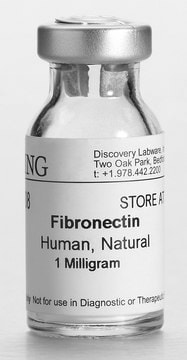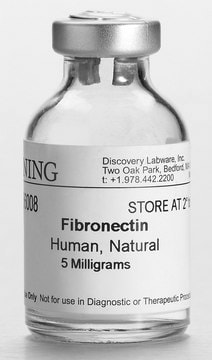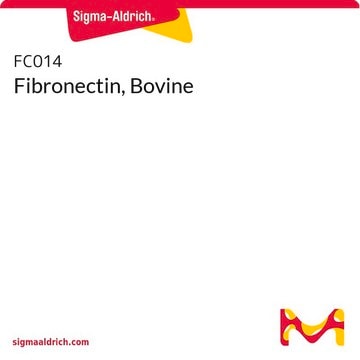F1056
Human Fibronectin
from human plasma, powder, suitable for cell culture
Synonim(y):
Fibronectin
About This Item
Polecane produkty
product name
Fibronectin human plasma, lyophilized powder, BioReagent, suitable for cell culture, ≥95% (SDS-PAGE)
pochodzenie biologiczne
human plasma
Poziom jakości
sterylność
sterile
linia produktu
BioReagent
Próba
≥95% (SDS-PAGE)
Postać
lyophilized powder
opakowanie
pkg of 1 mg
pkg of 2 mg
pkg of 5 mg
metody
cell culture | mammalian: suitable
pokrycie powierzchni
1‑5 μg/cm2
rozpuszczalność
H2O: 1 mg/mL at 37 °C
numer dostępu UniProt
Specyficzność wiązania
Peptide Source: Collagen
Warunki transportu
dry ice
temp. przechowywania
−20°C
informacje o genach
human ... FN1(2335)
Szukasz podobnych produktów? Odwiedź Przewodnik dotyczący porównywania produktów
Powiązane kategorie
Opis ogólny
Zastosowanie
- in neural selection medium to coat tissue culture surface for neuronal differentiation
- to coat culture vessels for characterization of iPSC and iPSC‑derived BMEC in 2D cell culture
- to coat culture supports for endothelial cell culture
Działania biochem./fizjol.
Przestroga
Uwaga dotycząca przygotowania
In coating culture surfaces, fibronectin should be diluted in sterile balanced sterile salt solution and coated with minimal volume. Surface should then be air dried for 45 minutes at room temp and can be stored for 2-4 weeks at 2-8°C.
Oświadczenie o zrzeczeniu się odpowiedzialności
Kod klasy składowania
11 - Combustible Solids
Klasa zagrożenia wodnego (WGK)
WGK 3
Temperatura zapłonu (°F)
Not applicable
Temperatura zapłonu (°C)
Not applicable
Środki ochrony indywidualnej
Eyeshields, Gloves, type N95 (US)
Certyfikaty analizy (CoA)
Poszukaj Certyfikaty analizy (CoA), wpisując numer partii/serii produktów. Numery serii i partii można znaleźć na etykiecie produktu po słowach „seria” lub „partia”.
Masz już ten produkt?
Dokumenty związane z niedawno zakupionymi produktami zostały zamieszczone w Bibliotece dokumentów.
Klienci oglądali również te produkty
Produkty
Białka macierzy zewnątrzkomórkowej, takie jak laminina, kolagen i fibronektyna, mogą być stosowane jako podłoża do mocowania komórek w hodowli komórkowej.
Extracellular matrix proteins such as laminin, collagen, and fibronectin can be used as cell attachment substrates in cell culture.
Protokoły
Dilute fibronectin for cell attachment, varying per cell type. Coating protocol, products, and FAQs provided.
Rozcieńczona fibronektyna do mocowania komórek, w zależności od typu komórek. Protokół powlekania, produkty i często zadawane pytania.
Nasz zespół naukowców ma doświadczenie we wszystkich obszarach badań, w tym w naukach przyrodniczych, materiałoznawstwie, syntezie chemicznej, chromatografii, analityce i wielu innych dziedzinach.
Skontaktuj się z zespołem ds. pomocy technicznej






